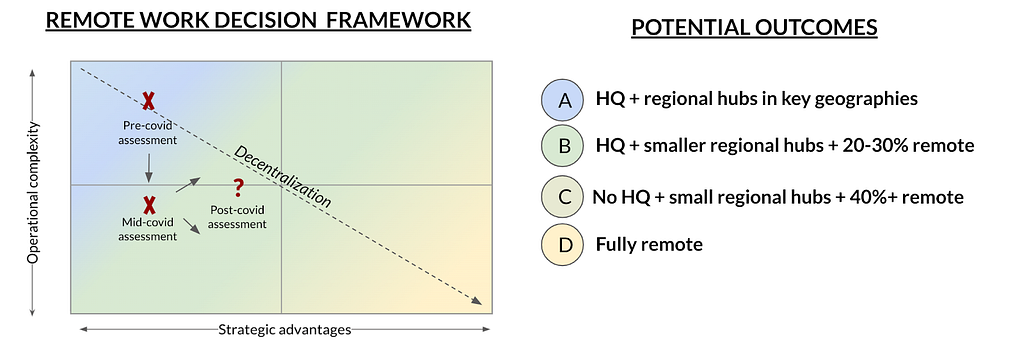Companies are thinking about how and when to have employees come back to work. Due to social distancing requirements, many are realizing that they will only be able to have up to 50% of employees return to offices at most.
At the same time, many companies are realizing that remote work has worked better than they expected. They are now asking themselves whether they should keep some portion of their work force remote indefinitely.
For most companies, it will be a mix of remote and in-office. Here’s why:
- Some employees are unable to stay remote indefinitely, because they are in difficult situations at home (studio apartment, no dedicated working space, distractions etc). Even when schools reopen and caregivers return to work, this will only partially alleviate the problem.
- Some employees don’t want to return to the office, because they are happier and more productive at home. Once given, items are more difficult to take away, and top talent will come to expect remote work as an option.
A common piece of advice one hears is that a hybrid state of remote and in-office is the worst of both worlds. But given the requirements above, most companies will end up here. So what is the solution?

The solution is to embrace the hybrid state and give it the best chance of success by turning your company into a remote-first culture.
What does remote-first mean?
Remote first means there is no disadvantage to working at home versus in-office. All employees have the same experience. If you don’t make the culture remote-first, you create a prisoner’s dilemma that encourages people to keep coming into offices.
Here is what remote-first means in practice:
1. Everyone dials in separately to meetings
Even if some employees are in one office, they each dial in separately to meetings.
2. More phone booths in office versus conference rooms
Employees dialing in to meetings from the office can do so from their desk, but they may want privacy in phone booth style small meeting rooms.
3. One floor in ten cities versus ten floors in one city
Companies will start to maintain lightweight offices in more cities (probably managed by third parties like WeWork), for employees who still want to come into an office, or direct employees to join co-working spaces. The rest will work from home. There will be less emphasis on a centralized headquarters with an expensive buildout that is customized to one company.
4. Less assigned seating
In the lightweight offices, companies will allocate some portion of desks that are first come first serve. Consulting companies have been doing this for years.
5. More written and asynchronous communication
Teams will rely more on wikis and written documentation. Gitlab has over 5,000 pages of public documentation about how they operate, and tools like Notion have made this easier than ever.
6. Clustering in certain time zones
Opening up most roles to remote work increases the top of funnel, but for everyone to have an equal experience it is beneficial to have employees clustered in certain time zones so that they can work together during the day.
Benefits to remote work
1. Hiring and retaining top talent
Location and commute are one of the biggest challenges companies face when hiring and retaining team members. I frequently hear “soul crushing commute” cited as a factor in departures here in San Francisco, and several friends have commented to me how much more productive/happy they are with an additional 1–2 hours every day where they are not commuting. Opening roles up to remote also dramatically increases the top of the funnel (probably by 1–2 orders of magnitude). A major part of recruiting effort is spent in convincing candidates and their families, often unsuccessfully, to relocate.
2. Employees will come to expect it
There is a fiercely competitive market for talent out there, especially in major hub cities. I believe that as more companies come to offer remote work options, companies who don’t will be at a disadvantage.
3. It de-risks centralizing too much in one location
As a company headquartered in San Francisco, employees have struggled with the rising cost of housing, long commutes, and to some extent quality of life. Part of the vision for Coinbase is to create a world with more economic freedom, and not being tied to one location is a key part of this. I expect that more companies over time will try to avoid vendor lock in, not just in the traditional sense, but in terms of where they are located.
4. Lifestyle
For those who have a suitable work environment set up at home (which is definitely not everyone), there is an aspect of remote work that just seems more fun. Employees can spend time in different cities without taking vacation days, see their children grow up, and avoid noisy or interruption prone offices.
Of course, it’s true that remote work is not better in all aspects.
Risks of remote work
1. Reduced collaboration and creativity
The early stages of remote work can feel more productive, as you finally get to race through your backlogged todo list. But what happens when alignment (that was largely generated in person), starts to fade? Moreover, how do we replace the unplanned moments of serendipity, walking by someone’s desk or lunch table, that lead to new ideas and innovation. More practically, how do you replace the whiteboard?
Potential mitigant: host regular in person meetups for each team, say twice a year.
2. Reduced camaraderie
Working remotely can get lonely. It will be interesting to learn more about remote work’s impact on morale, belonging, loyalty, and retention.
Potential mitigant: recreate team bonding moments virtually, with a variety of tools coming on the market [1 2], in addition to bi-annual in person meetups.
3. Home office set up
While it’s relatively straightforward to get employees the equipment they need, the real question is whether they have the space to use it. Home offices are a bit of a luxury, and a far cry from what many SF residents experience. High rent means less space and more roommates — not ideal for a home office.
Potential mitigant: Give employees the option to work from co-working spaces, or more lightweight offices that the company maintains in certain locations. Give employees budgets and guidance on great work from home setups. [1] Remote work also opens up hiring to lower cost of living locations where employees may have more space.
4. Performance management
It could be tempting for employees to relax their standards without a manager nearby. Remote work comes with a lot of freedom, so it’s important to have high trust that employees will deliver high quality work. An interesting choice to explore is whether remote work should be the default or an earned privilege.
Potential mitigant: practice measuring outputs, not inputs. Note: this is probably best practice in general, since it’s easy to appear busy in an office as well, without getting much done.
5. Learning and development
It can be more difficult for more new and less experienced employees to get up to speed when there is no neighbor to turn to and ask for help.
Potential mitigant: emphasize in onboarding that it is not just ok, but expected, to ask for help if you are stuck on something for more than 15 minutes. Invest in better documentation using wiki software like Notion and Confluence.
6. Time zones
Remote work suffers when teammates don’t have overlapping times of day where they can collaborate.
Potential mitigant: Publish a set of tier 1 (preferred), tier 2 (tolerated), and tier 3 (only approved by exception) time zones to focus your recruiting efforts.
Conclusion
I was initially skeptical of remote work as a way to build a top tier company, but I must say that this forced experiment, brought about by COVID19, has really made me reconsider. Companies have an incredible amount of overhead maintaining various offices and getting employees to show up in the right places physically. It reminds me of companies managing their own data centers before AWS. A remote company can be more nimble and dynamic.
I also can’t wait to see how remote work tools advance with this new wave of investment. VR, whiteboards, and getting all the little details right around lighting, sharing, knowing when to speak, etc will improve greatly in the coming years. Today, an in person meeting is still better than remote (all else being equal), but that gap is closing.
We are trying to figure this out, along with everyone else, and I would say my thinking on it is still evolving. I wanted to collect my thoughts in one place here to help us learn, share with others, and get additional feedback. I’m sure our thinking will continue to evolve over time.
If you are interested in figuring out the future of remote work with us, please check out our open roles and apply for a position. You may be seeing more remote roles open here soon!
How companies will work post COVID19: embracing a remote-first culture. was originally published in The Coinbase Blog on Medium, where people are continuing the conversation by highlighting and responding to this story.
The post appeared first on The Coinbase Blog






